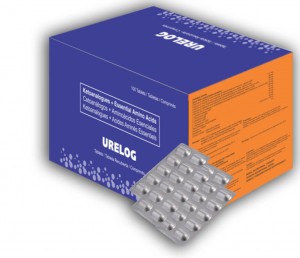Urelog
URELOG is generally known as Compound α-Ketoacid Tablets and it is used for preventing and treating renal damages due to protein metabolism disorder in chronic kidney disease (CKD) and the effects are better with low-protein diets. It is usually applied to those that have Glomerular Filtration Rate (GFR) less than 25ml/min and the standard of low-protein diet is 40g/day or less for adults
There are many treatments for Chronic Kidney Failure helps lower creatinine level. Metabolic disorders of protein, amino acid are very common among renal failure patients and they are in a state of negative nitrogen balance.
URELOG can supply amino acid and reduce the producing of urea and help lower the level of creatinine and urea nitrogen and at the same time improve the nutritional status.
URELOG and low-protein diet can achieve the following functions:
- Alleviate the symptoms of uremia. The symptoms and discomforts of uremia are caused by the excessive accumulation of metabolic wastes of proteins.
- Protect the remaining renal functions and slow down the progression of illness conditions.
- Guarantee the patients’ nutrition even with obvious reduction of protein intake & Improve the metabolic complications due to renal insufficiency.
URELOG have side effects while lowering creatinine?
URELOG does have certain effects on lowering creatinine, but it still depends on the patients’ illness and physical conditions and patients should not rely on URELOG only. The root cause of increased creatinine level is the damage of renal intrinsic cells and tissues and the decreased ability of the glomerular filtration, therefore when the damaged parts are repaired and the glomerular filtration rate is improved the accumulated creatinine and other wastes will be filtered out of the body by the kidneys and the creatinine level will decrease naturally.
URELOG treat kidney failure effectively?
URELOG is indicated for prevention and psychoanalysis in chronic renal insufficiency contained by connection beside a low protein diet. URELOG contain essential amino acids by the form of their hydroxy and keto analogues as calcium salts.
URELOG treats kidney failure?
A certain amount of URELOG can absorb excessive ammonia and transformed it into relative α-amino acid with the help of zymic function, which can decrease ammonia concentration, and prevent ammonia poisoning. So URELOG can also treat uremia caused by renal failure and can relieve suffering from dialysis in some extent.
Which group of kidney disease patients can not apply URELOG?
- Firstly, renal failure patients who have Hypercalcemia and disorder of amino acid catabolism are forbidden to use it.
- Secondly, URELOG cannot be used together with other medicine which contains calcium.
ADVANTAGES:
- URELOG along with low protein intake can correct the carbohydrate metabolism disorder.
- It can reduce insulin resistance, increase energy and relieve hyperinsulinemia. Therefore, URELOG is quit suitable for the patients with Chronic Renal Insufficiency, especially those caused by type 2 Diabetes.
- URELOG can increase the supplement of necessary amino acid and reduce the intake of amino nitrogen. It can utilize the nitrogen in unnecessary amino nitrogen to convert to amino acid so as to decline the synthesis of urea and accumulation of uremic toxins. Therefore, URELOG can keep the patients’ protein needs even if they reduce the protein in their diet.
- When the patients take URELOG, they need to keep low non-animal protein intake which can reduce the phosphorus. Meanwhile,
- URELOG also contain calcium. Therefore, URELOG can correct the metabolic disorder of phosphorus and calcium.
- In addition, URELOG can produce insoluble calcium- phosphate which can prevent the absorption of phosphorus.
DISADVANTAGE:
- Taking URELOG needs the patients to limit the animal protein intake strictly so, it can reduce the sources of phosphorus from foods.
- Also it can restrain the absorption of phosphorus by intestinal tract. Therefore, it is very likely to cause the calcium in blood to rise thus resulting in hypercalcemia which can cause multiple systems like digestive system, urinary system and renal tubule etc.
- If hypercalcemia occurs, the patients are recommended to reduce vitamin D supplement.
- If the blood calcium level keeps high persistently, they should reduce URELOG dosage and other substance with calcium. Therefore, it is very essential for the patients to measure their blood calcium level regularly.
- The high levels of metabolic products like creatinine, urea etc are caused by the decreased renal excretion function. As the kidneys are impaired, they cannot function well as before.
What does Urelog contains?
| 1. QUALITATIVE AND QUANTITATIVE COMPOSITION |
| One coated tablet contains: |
| (RS)-3-methyl-2-oxovaleric acid (α-ketoanalogue to DL-isoleucine), calcium-salt 67 mg |
| 4-methyl-2-oxovaleric acid (α-ketoanalogue to leucine), calcium-salt 101 mg |
| 2-oxo-3-phenylpropionic acid (α-ketoanalogue to phenylalanine), calcium-salt 68 mg |
| 3-methyl-2-oxobutyric acid (α-ketoanalogue to valine), calcium salt 86 mg |
| (RS)-2-hydroxy-4-methylthio-butyric acid (α-hydroxyanalogue to DL-methionine), calcium-salt 59 mg |
| L-lysine acetate 105 mg |
| L-threonine 53 mg |
| L-tryptophan 23 mg |
| L-histidine 38 mg |
| L-tyrosine 30 mg |
| Total nitrogen content per tablet 36 mg |
| Calcium content per tablet 1.25 mmol 50 mg |
INDICATIONS:
Prevention and therapy of damages due to faulty or deficient protein metabolism in chronic renal insufficiency in connection with limited protein in food of 40 g per day (for adults) and less; i.e. generally in patients with a glomerular filtration rate (GFR) below 25 ml/min.
CONTRA INDICATIONS:
Hypercalcemia, disturbed amino acid metabolism. In case of hereditary phenyl ketonurie it has to be taken into account that this product contains phenylalanine.
DOSAGE:
Take 4 to 8 tablets three times a day during meals. This dosage applies to adults (70 kg body weight). URELOG tablets are given as long as the glomerular filtration rate (GFR) is below 25 ml/min and a diet with an intake of max. 40 g protein per day (for adults) is followed.